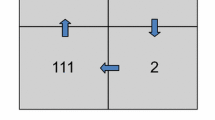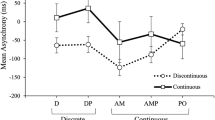Abstract
Rhythmic movement coordination exhibits characteristic patterns of stability, specifically that movements at 0° mean relative phase are maximally stable, 180° is stable but less so than 0°, and other coordinations are unstable without training. Recent research has demonstrated a role for perception in creating this pattern; perceptual variability judgments covary with movement variability results. This suggests that the movement results could be due in part to differential perceptual resolution of the target movement coordinations. The current study used a paradigm that enabled simultaneous access to both perception (between-trial) and movement (within-trial) stability measures. A visually specified 0° target mean relative phase enabled participants to produce stable movements when the movements were at a non-0° relationship to the target being tracked. Strong relationships were found between within-trial stability (the traditional movement measure) and between-trial stability (the traditional perceptual judgment measure), suggestive of a role for perception in producing coordination stability phenomena. The stabilization was incomplete, however, indicating that visual perception was not the sole determinant of movement stability. Rhythmic movement coordination is intrinsically a perception/action system.











Similar content being viewed by others
Notes
Having to rely on circular statistics such as MVL means that the discussion of results will be reversed from what is usual in the movement coordination literature. Instead of “variability” (which increases with standard deviation) we will instead use “stability”, which increases with MVL. This should be kept in mind when comparing this data with previous results. Transforming the data by ln(1/MVL) rescales MVL to more closely resemble a standard deviation, however, we wished to minimize the number of data transformations we performed
This effect can clearly be seen in Fig. 2—the predicted U-shaped function is pronounced in the between-trial data but absent in the within-trial data. In the 90:90 condition, participants spent time at more stable relative phases, elevating the within-trial stability to be similar to that at 180:180, and lowering the between-trial stability
References
Batschelet E (1981) Circular statistics in biology. Academic, New York
Beek PJ, Peper CE, Deffertshofer A (2002) Modeling rhythmic interlimb coordination: beyond the Haken-Kelso-Bunz model. Brain Cogn 48:149–165
Bingham GP (2004a) A perceptually driven dynamical model of bimanual rhythmic movement (and phase perception). Ecol Psychol 16(1):45–53
Bingham GP (2004b) Another timing variable composed of state variables: phase perception and phase driven oscillators. In: Hecht H, Savelsbergh GJP (eds) Advances in psychology 135: time-to-contact. Elsevier, Amsterdam
Bingham GP, Schmidt RC, Zaal FTJM (1999) Visual perception of relative phasing of human limb movements. Percept Psychophys 61:246–258
Bingham GP, Zaal FTJM, Shull JA, Collins D (2000) The effect of frequency on visual perception of relative phase and phase variability of two oscillating objects. Exp Brain Res 136:543–552
Bogaerts H, Buekers MJ, Zaal FTJM, Swinnen SP (2003) When visuo-motor incongruence aids motor performance: the effect of perceiving motion structures during transformed visual feedback on bimanual coordination. Behav Brain Res 138:45–57
Buekers MJ, Bogaerts HP, Swinnen SP, Helsen WF (2000) The synchronization of human arm movements to external events. Neurosci Lett 290:181–184
Byblow WD, Chua R, Bysouth-Young DF, Summers JJ (1999) Stabilisation of bimanual coordination through visual coupling. Hum Mov Sci 18:281–305
Cattaert D, Semjen A, Summers JJ (1999) Simulating a neural cross-talk model for between-hand interference during bimanual circle drawing. Biol Cybern 81:343–358
Fisher NI (1993) Statistical analysis of circular data. Cambridge University Press, Cambridge
Haken H, Kelso JA, Bunz H (1985) A theoretical model of phase transitions in human hand movements. Biol Cybern 51:347–356
Jammalamadaka SR, SenGupta A (2001) Topics in circular statistics. World Scientific Publishing, NJ
Johansson G (1950) Configuration in event perception. Almqvist and Wiksell, Stockholm
Kay BA, Kelso JAS, Saltzman EL, Schöner G (1987) Space–time behavior of single and bimanual rhythmical movements: data and limit cycle model. J Exp Psychol Hum 13:178–192
Kay BA, Saltzman EL, Kelso JAS (1991) Steady-state and perturbed rhythmical movements: a dynamical analysis. J Exp Psychol Hum 17:183–197
Kelso JAS (1984) Phase transitions and critical behavior in human bimanual coordination. Am J Phys 15:R1000–R1004
Kelso JAS, Scholz JP, Schöner G (1986) Nonequilibrium phase transitions in coordinated biological motion: critical fluctuations. Phys Lett A 118:297–284
Kelso JAS, Schöner G, Scholz JP, Haken H (1987) Phase-locked modes, phase transitions and the component oscillators in biological motions. Phys Scripta 35:79–87
Li Y, Levin O, Carson RG, Swinnen SP (2004) Bimanual coordination: constraints imposed by the relative timing of homologous muscle activation. Exp Brain Res 156:27–38
Liao M, Jagacinski RJ (2000) A dynamical systems approach to manual tracking performance. J Motor Behav 32(4):361–378
Mardia KV (1972) Statistics of directional data. Academic, New York
Mechsner F, Kerzel D, Knoblich G, Prinz W (2001) Perceptual basis of bimanual coordination. Nature 414:69–73
Mechsner F, Knoblich G (2004) Do muscles matter for coordinated action? J Exp Psychol Hum 30(3):490–503
Pagano CC, Bingham GP (1998) Comparing measures of monocular distance perception: verbal and reaching errors are not correlated. J Exp Psychol Hum 24(4):1037–1051
Schmidt RC, Carello C, Turvey MT (1990) Phase transitions and critical fluctuations in the visual coordination of rhythmic movements between people. J Exp Psychol Hum 16:227–247
Serrien DJ, Li Y, Steyvers M, Debaere F, Swinnen SP (2001) Proprioceptive regulation of interlimb behavior: interference between passive movement and active coordination dynamics. Exp Brain Res 140:411–419
Temprado JJ, Swinnen SP, Carson RG, Tourment A, Laurent M (2003) Interaction of directional, neuromuscular and egocentric constraints on the stability of preferred bimanual coordination patterns. Hum Mov Sci 22:339–363
Wilson AD, Bingham GP, Craig JC (2003) Proprioceptive perception of phase variability. J Exp Psychol Hum 29(6):1179–1190
Wimmers RH, Beek PJ, van Wieringen PCW (1992) Phase transitions in rhythmic tracking movements: a case of unilateral coupling. Hum Move Sci 11:217–226
Zaal FTJM, Bingham GP, Schmidt RC (2000) Visual perception of mean relative phase and phase variability. J Exp Psychol Hum 26:1209–1220
Acknowledgements
We thank Joshua Isaacson for his help in collecting the data. The Indiana University super-computing cluster is supported by the National Science Foundation under Grant No. 0116050. Portions of this data were presented at the 3rd Annual Meeting of the Vision Sciences Society, Sarasota, FL, May 9–14 2003.
Author information
Authors and Affiliations
Corresponding author
Rights and permissions
About this article
Cite this article
Wilson, A.D., Collins, D.R. & Bingham, G.P. Perceptual coupling in rhythmic movement coordination: stable perception leads to stable action. Exp Brain Res 164, 517–528 (2005). https://doi.org/10.1007/s00221-005-2272-3
Received:
Accepted:
Published:
Issue Date:
DOI: https://doi.org/10.1007/s00221-005-2272-3




